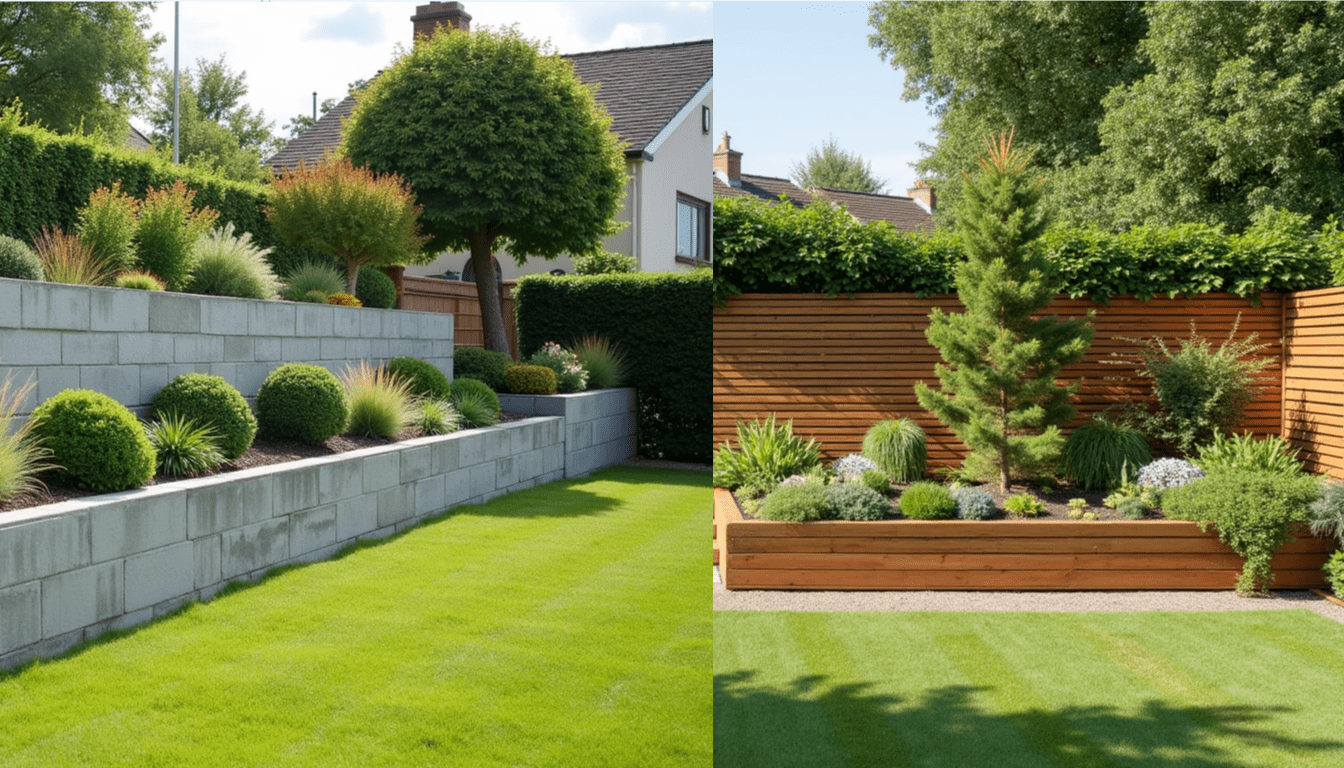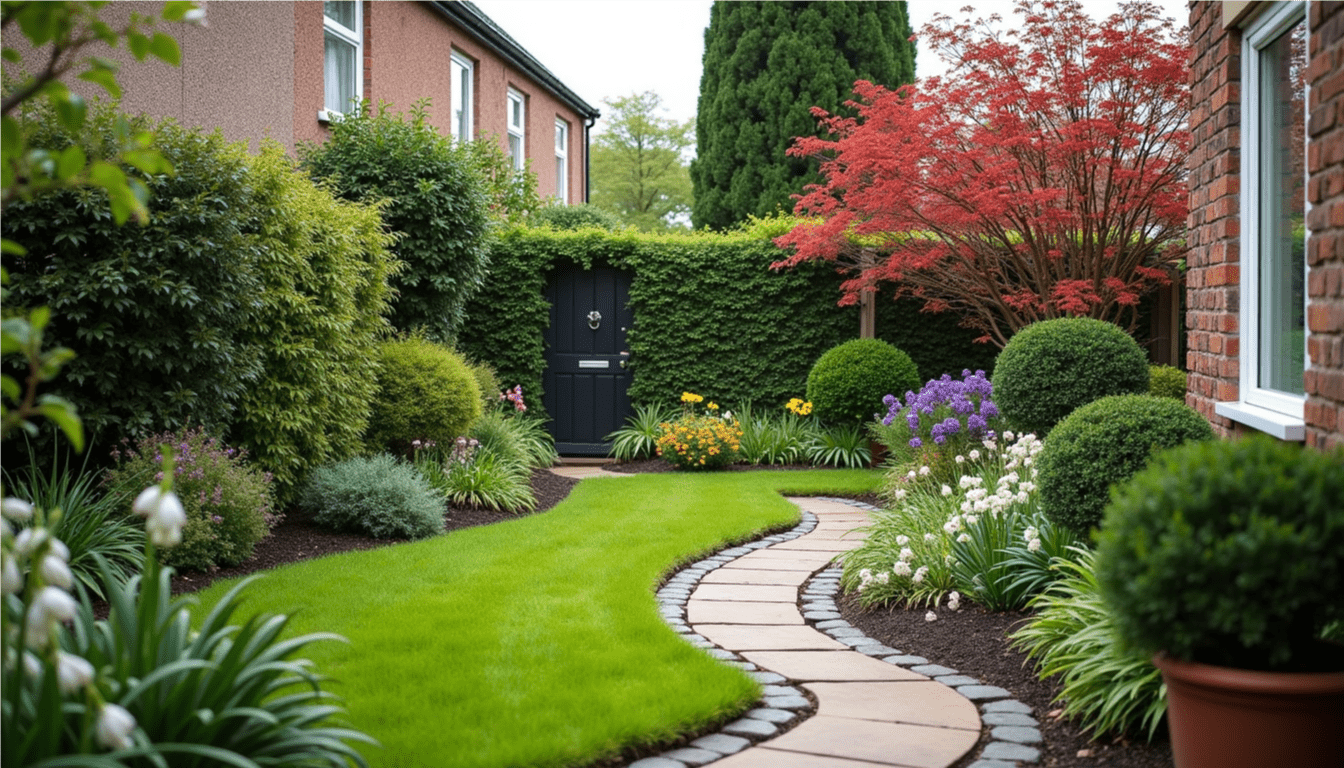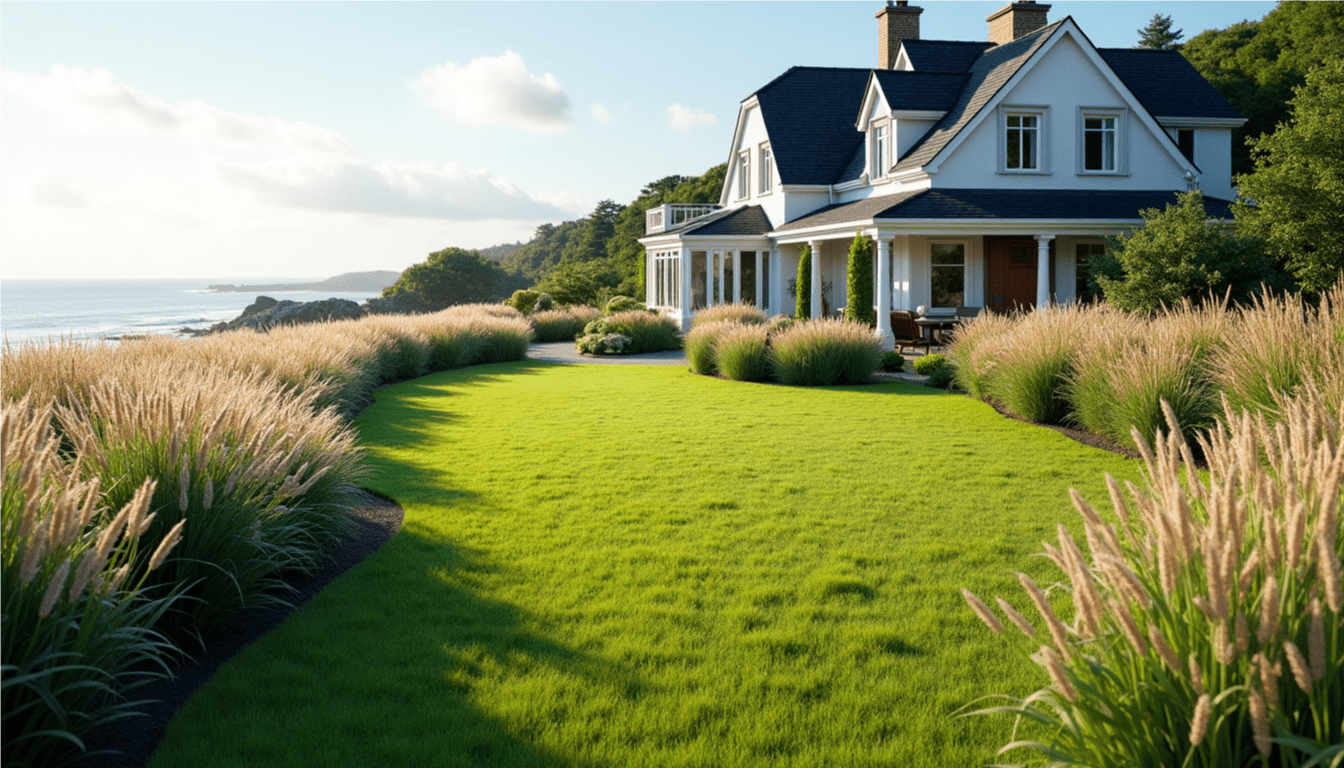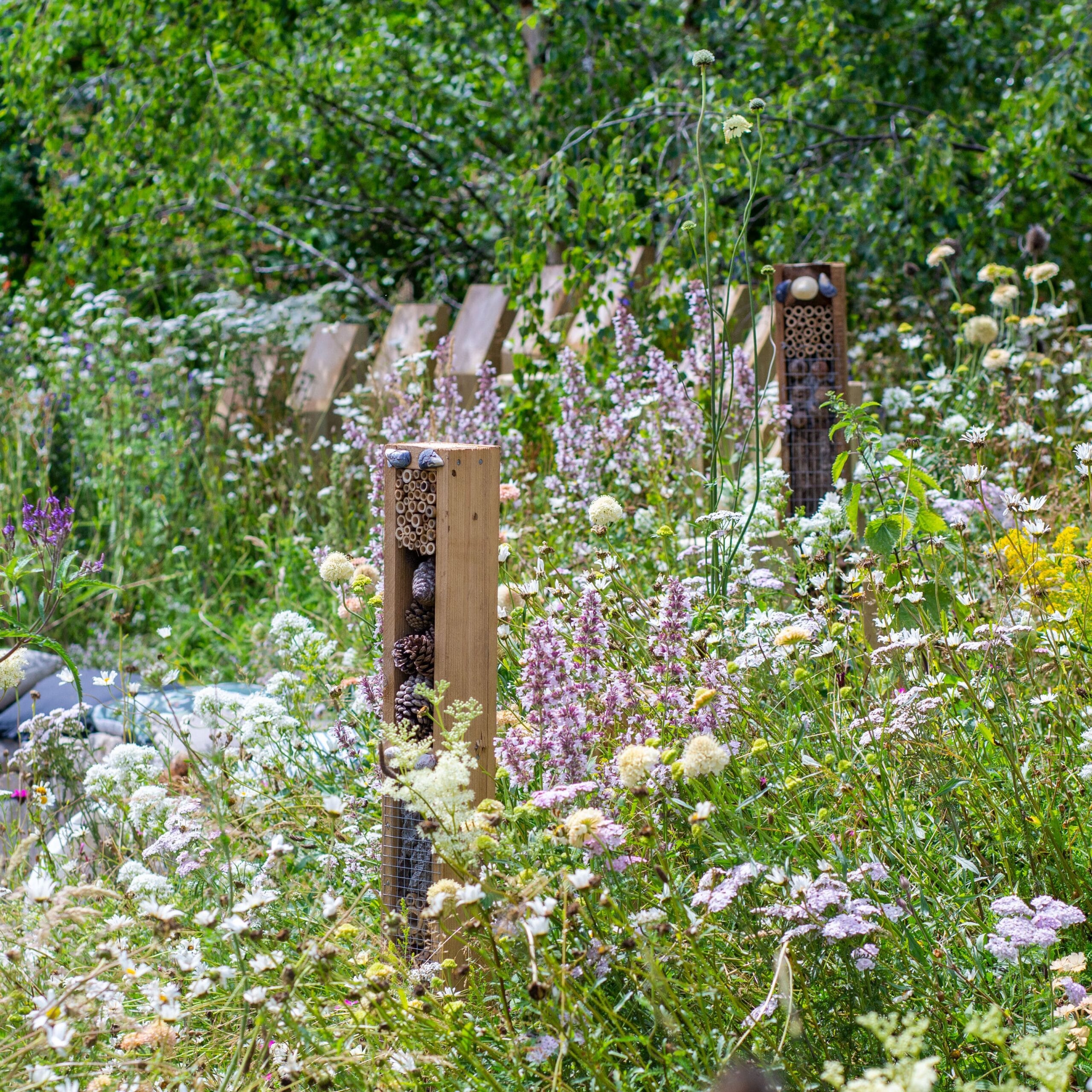
Key Takeaways
- Concrete sleepers offer superior durability in Ireland’s wet climate, with resistance to rot, pests, and harsh weather conditions.
- Timber sleepers provide natural aesthetic appeal and are generally more cost-effective upfront, making them ideal for smaller garden projects.
- Proper drainage is essential for both types of retaining walls to prevent structural damage and extend their lifespan.
- The height of your planned retaining wall should influence your material choice, with concrete being preferred for taller structures.
- Dublin Landscape Gardener can help you determine which sleeper material best suits your specific garden needs and Irish weather conditions.
Why Your Retaining Wall Choice Matters in Ireland
Choosing the right material for your retaining wall is a critical decision that impacts both the functionality and appearance of your Irish landscape. Ireland’s climate, with its frequent rainfall and varying temperatures, demands materials that can withstand these conditions while complementing your garden aesthetic. Dublin Landscape Gardener understands that this decision affects not just the immediate appearance of your garden, but its long-term maintenance requirements and durability.
Retaining walls serve crucial functions in Irish gardens – they prevent soil erosion, create level areas on sloped properties, and define garden spaces with style. Whether you’re building a simple garden border or tackling a significant landscaping project, the material you choose will determine how well your wall performs these functions over time.
In Ireland’s damp climate, material durability becomes particularly important. The constant cycle of wet and dry conditions can accelerate deterioration in some materials while having minimal impact on others. This is why understanding the specific properties of concrete and timber sleepers is essential before making your investment.
Book a Landscape Garden Consultation
A personal creative landscape garden designed to bring your vision to life!
Concrete Sleepers: Strength Meets Longevity
1. Superior durability in Irish weather conditions
Concrete sleepers excel in Ireland’s variable climate, offering exceptional resistance to the frequent rain, occasional freezing temperatures, and strong winds that characterize Irish weather patterns. Unlike timber, concrete doesn’t absorb moisture, which is a significant advantage in Ireland’s damp environment. This moisture resistance prevents the material from swelling, warping, or deteriorating over time.
The density and composition of concrete sleepers make them incredibly stable in varying ground conditions. This stability is particularly valuable in Ireland, where soil can become waterlogged during extended rainy periods. Concrete’s inherent strength allows it to maintain structural integrity even when soil conditions fluctuate between wet and dry.
2. Resistance to rot, pests, and deterioration
One of the most compelling advantages of concrete sleepers is their complete immunity to common problems that plague organic materials. Concrete is impervious to insect attacks, including termites and wood-boring beetles that can devastate timber structures. It also doesn’t rot or decay, regardless of how wet conditions become.
This resistance translates to lower replacement costs and fewer maintenance headaches for Irish homeowners. In areas particularly prone to damp conditions, such as properties near water features or in low-lying areas of counties like Kerry or Donegal, concrete sleepers can significantly outperform timber in terms of structural longevity.
3. Available design options and finishes
Modern concrete sleepers have evolved far beyond the plain gray blocks of the past. Today’s options include sleepers with various finishes that complement any garden style. Smooth-finished concrete sleepers offer a contemporary look that pairs well with modern landscaping designs, while textured options can provide more visual interest.
One particularly popular option in Ireland is woodgrain-textured concrete sleepers, which provide the aesthetic appeal of timber with the durability of concrete. These sleepers feature impressions that mimic the grain patterns of natural wood, offering a compromise between natural appearance and practical durability.
Color options have also expanded, with concrete sleepers now available in charcoal, sandstone, and earth tones that blend beautifully with Irish garden environments. This variety allows homeowners to match their retaining walls to existing hardscaping elements or to create deliberate contrast for visual impact.
4. Minimal maintenance requirements
Concrete sleepers offer a nearly maintenance-free option for busy homeowners. Unlike timber, which may require regular staining, sealing, or treatment to maintain its appearance and structural integrity, concrete sleepers need little more than occasional cleaning to remove any buildup of dirt or algae.
This low-maintenance characteristic is particularly valuable in Ireland’s climate. The frequent rainfall can accelerate the growth of moss and algae on outdoor structures, but concrete sleepers can typically be cleaned with a simple pressure washing. This makes them an ideal choice for homeowners who want to enjoy their gardens without dedicating significant time to maintenance tasks.
Book a Landscape Garden Consultation
A personal creative landscape garden designed to bring your vision to life!
Additionally, concrete sleepers maintain their appearance over time, with minimal fading or deterioration even after years of exposure to Irish weather conditions. This consistency means your garden design will look as intended for many years to come.
Timber Sleepers: Natural Charm with Considerations
1. Aesthetic appeal in Irish landscapes
Timber sleepers bring undeniable natural warmth and character to Irish gardens. Their organic texture and appearance integrate seamlessly with planted areas, creating a harmonious look that many homeowners prefer. In rural Irish settings particularly, timber sleepers complement traditional garden designs and countryside aesthetics.
The natural aging process of timber adds to its charm, as the wood weathers to a silvery-gray patina over time. This aging process creates a lived-in, established look that’s difficult to replicate with manufactured materials. For properties where maintaining a natural, rustic appearance is a priority, timber sleepers remain an excellent choice.
The versatility of timber also allows for easier on-site modifications. Timber sleepers can be cut to specific lengths or shapes as needed during installation, making them adaptable to creative or unusual garden designs. This flexibility is particularly useful in Irish cottage gardens or properties with irregular boundaries.
2. Initial cost advantages
One of the most immediate advantages of timber sleepers is their lower initial purchase price compared to concrete alternatives. This cost difference makes timber an attractive option for budget-conscious projects or larger retaining walls where material quantities significantly impact overall expenses.
The lighter weight of timber sleepers also translates to lower transportation costs, which can be a consideration for projects in remote areas of Ireland. Additionally, timber’s lighter weight makes it more manageable for DIY installations, potentially saving on professional installation costs for smaller projects.
For homeowners planning temporary structures or those with shorter-term landscaping plans, the lower investment in timber sleepers can make financial sense. The initial savings may outweigh long-term durability considerations if the retaining wall is not intended as a permanent feature of the landscape.
3. Treatment and maintenance needs
While timber sleepers require more maintenance than concrete, modern treatment options have significantly improved their longevity. Pressure-treated timber sleepers are infused with preservatives that help resist rot, fungi, and insect damage, extending their useful life considerably compared to untreated wood.
Regular maintenance typically involves applying a protective sealant every few years to maintain water resistance and prevent degradation. In Ireland’s damp climate, this maintenance schedule may need to be more frequent than in drier regions. Some homeowners appreciate this maintenance as an opportunity to refresh the appearance of their retaining walls, perhaps changing the color or finish to update their garden aesthetic.
It’s worth noting that different timber species offer varying levels of natural durability. Hardwoods like oak and cedar naturally resist decay better than softwoods, though this resistance is reflected in their higher cost. For Irish gardens, selecting the appropriate timber species based on the location’s exposure to moisture is an important consideration.
Installation Factors That Influence Success
1. Ground preparation differences
Proper ground preparation is crucial regardless of whether you choose concrete or timber sleepers, but there are important differences in the approach. For concrete sleepers, which are significantly heavier, a solid foundation is essential. This typically involves excavating to a depth of at least 300mm and creating a compacted hardcore base topped with a layer of sand or concrete.
This robust foundation distributes the weight of concrete sleepers evenly and prevents sinking or shifting over time. In Ireland’s often-saturated soils, proper drainage within this foundation becomes particularly important to prevent water accumulation that could undermine stability.
Timber sleeper installations, while still requiring careful preparation, can sometimes be less intensive. The lighter weight of timber means foundation requirements may be less stringent for lower walls. However, because timber is more vulnerable to moisture damage, creating proper drainage is arguably even more important than with concrete to extend the wall’s lifespan.
2. Securing methods for each material
The methods used to secure sleepers in place differ significantly between concrete and timber. Concrete sleepers typically require steel H-posts driven deep into the ground before the sleepers are slotted between them. These posts provide crucial support and stability, particularly for taller retaining walls that must withstand significant soil pressure.
The weight of concrete sleepers works to their advantage here, as the mass helps resist the pressure exerted by the retained soil. Additionally, concrete sleepers can be reinforced with rebar during manufacturing for added strength, making them suitable for walls of considerable height.
Timber sleepers are typically secured using a different approach. Long metal spikes or wooden stakes can be driven through the sleepers into the ground below, anchoring them in place. Alternatively, sleepers can be secured to each other using long coach screws or bolts, creating a unified structure that resists movement.
For both materials, the connection points between sleepers are critical to the wall’s overall stability. Ensuring these connections are secure and properly executed is often where professional installation expertise becomes most valuable.
3. Essential drainage solutions
Perhaps the most important aspect of any retaining wall installation in Ireland is drainage. Without proper water management, even the most carefully constructed wall can fail prematurely. Hydrostatic pressure from water buildup behind a wall can exert tremendous force, potentially causing bulging, leaning, or complete failure.
For both concrete and timber retaining walls, installing a drainage system behind the wall is essential. This typically involves:
- Creating a layer of free-draining material (such as gravel) immediately behind the wall
- Installing drainage pipes at the base to channel water away from the structure
- Using a geotextile membrane to separate the drainage material from the backfill soil
A properly designed drainage system is particularly important in Ireland’s clay-rich soils, which can otherwise block drainage pathways. The difference between materials comes in how they handle water contact. Concrete sleepers can withstand direct and prolonged water exposure without degradation, making them more forgiving if drainage systems become partially compromised. Timber sleepers, however, require more vigilant drainage maintenance to prevent accelerated decay.
Performance in Irish Conditions
Ireland’s climate presents specific challenges for outdoor structures. The combination of frequent rainfall, occasional freezing temperatures, and exposure to salt-laden air in coastal areas creates an environment that can rapidly degrade unsuitable materials.
Concrete sleepers perform exceptionally well under these conditions. Their resistance to moisture means they don’t expand and contract with changing humidity levels, which helps maintain the wall’s structural integrity throughout seasonal changes. In coastal areas of counties like Cork, Galway or Dublin, concrete’s resistance to salt corrosion makes it particularly valuable for long-term installations.
Timber sleepers, while more vulnerable to moisture damage, can still perform well when properly treated and maintained. Regular inspection and maintenance are key to ensuring their longevity in Irish conditions. The natural flexibility of timber can actually be advantageous during ground movement, as it allows for slight adjustments without cracking.
Both materials must contend with Ireland’s occasionally freezing temperatures. Here, concrete’s density provides good insulation against freeze-thaw cycles, while timber’s natural insulating properties also offer protection. However, proper drainage remains critical for both materials to prevent water from freezing within or behind the wall structure.
Practical Applications and Design Possibilities
1. Height and structural capabilities
The practical height limitations of retaining walls differ significantly between concrete and timber sleepers. Concrete sleepers, with their superior strength and the option for steel reinforcement, can be used for walls of considerable height – often up to 2 meters or more when properly engineered and installed with appropriate reinforcement.
This makes concrete sleepers the clear choice for significant landscaping projects that require retaining large volumes of soil or creating dramatic level changes in a garden. The ability to build higher walls also means fewer terraced levels may be needed to navigate steep slopes, potentially simplifying the overall design.
Timber sleepers, while strong, are generally limited to lower retaining walls – typically up to about 1 meter in height for standard installations. Beyond this height, the pressure exerted by the retained soil can become too great for timber to reliably withstand over time, particularly as the material ages.
For very low retaining walls or garden borders under 500mm in height, both materials perform admirably, and the choice becomes more about aesthetic preference and budget considerations rather than structural requirements.
2. Curved designs and flexibility
Creating curved retaining walls presents different challenges depending on the material chosen. Timber sleepers offer greater flexibility for curved designs, as they can be more easily cut to create gentle curves or even tight corners. This adaptability makes timber an excellent choice for gardens with organic, flowing designs where straight lines would look out of place.
Concrete sleepers, being precast and rigid, are more challenging to use in curved applications. While gentle curves can sometimes be achieved by creating a series of short, straight sections that approximate a curve, truly rounded designs are difficult to execute with standard concrete sleepers. Some manufacturers now offer shorter concrete sleeper sections specifically for curved applications, though these may come at a premium price.
For projects requiring both height and curves, a hybrid approach might be optimal – using concrete for taller, straight sections and timber for lower, curved elements. This combines the structural advantages of concrete with the design flexibility of timber.
3. Integration with existing landscape features
Both concrete and timber sleepers can be successfully integrated with existing landscape features, though they create different aesthetic effects. Timber sleepers blend naturally with wooden elements like decking, pergolas, or wooden fencing, creating a cohesive look across different garden structures. Their organic nature also complements planted areas, seeming to emerge from the landscape rather than imposing upon it.
Concrete sleepers pair well with other hardscaping elements such as stone patios, concrete paths, or rendered walls. Their clean lines and contemporary appearance can create striking visual contrasts with softer planted areas, defining spaces clearly within the garden design.
Both materials can be combined with stone, gravel, or other landscaping materials to create interesting textural contrasts. Planting pockets can be incorporated into both types of retaining walls, allowing vegetation to soften their appearance and integrate them more fully into the garden environment.
Environmental Considerations for Irish Gardens
Environmental impact is increasingly important to many Irish homeowners when selecting materials for their gardens. Both concrete and timber sleepers have environmental considerations worth examining.
Concrete production does have a carbon footprint due to the energy-intensive manufacturing process. However, concrete sleepers’ exceptional longevity means they rarely need replacement, reducing their lifetime environmental impact. Additionally, at the end of their useful life, concrete can potentially be crushed and recycled as aggregate for other construction projects.
Timber sleepers present a different environmental profile. Responsibly sourced new timber from sustainably managed forests represents a renewable resource, with new trees planted to replace those harvested. However, the pressure treatments used to protect timber from decay contain chemicals that can leach into soil over time, potentially affecting nearby plants or groundwater.
For environmentally conscious gardeners in Ireland, seeking FSC-certified timber sleepers treated with more environmentally friendly preservatives represents a good compromise between durability and environmental responsibility. Alternatively, composite sleepers made from recycled materials are becoming more widely available, though they typically come at a higher price point.
Making the Right Choice for Your Project
Selecting between concrete and timber sleepers ultimately comes down to balancing several factors specific to your project:
- Project lifespan: For permanent structures intended to last decades with minimal maintenance, concrete sleepers usually represent the better investment despite higher initial costs. For temporary or shorter-term projects, timber’s lower upfront cost may be more attractive.
- Aesthetic preferences: If you’re seeking a natural, rustic look that ages gracefully, timber sleepers will likely better satisfy your design vision. For clean, contemporary lines and consistent appearance over time, concrete sleepers are superior.
- Installation considerations: DIY installers often find timber easier to work with due to its lighter weight and the ability to cut it on site. Concrete generally requires more equipment and potentially professional installation, especially for larger projects.
- Budget constraints: While timber offers lower initial costs, concrete’s reduced maintenance and longer lifespan often make it more economical over the long term. Consider both immediate budget limitations and lifetime costs when making your decision.
- Site conditions: For very wet sites or areas prone to flooding, concrete’s superior water resistance makes it the safer choice. For sites where ground movement is expected, timber’s natural flexibility might be advantageous.
Many successful Irish gardens incorporate both materials, using each where its strengths are most valuable. A thoughtfully designed landscape might use concrete sleepers for critical structural walls and timber for decorative elements or garden borders, creating a balanced and functional outdoor space.
Whatever material you choose for your retaining wall project, proper installation is key to ensuring long-term success and stability. For expert advice on selecting and installing the right sleeper material for your specific Irish garden conditions, contact Dublin Landscape Gardener.
Book a Landscape Garden Consultation
A personal creative landscape garden designed to bring your vision to life!





